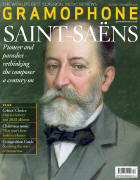Texte paru dans: / Appeared in: |
|
|
Outil de traduction |
|
|
Reviewer: Rob Cowan Two interesting aspects of Fabio Biondi’s deeply personal set of the Bach solo violin works beg close attention: their considerable interpretative freedom and the presence of vibrato, the latter not a given by any means, but frequent enough to mark Biondi out from various other players who inhabit the HIP camp. Material that’s repeated carries a plethora of ornaments, in the finales to the G minor and A minor Sonatas, for example, where the repeats for both halves turn somersaults on added runs and ornate decorations. This pattern recurs throughout the whole series. Biondi has a knack of letting the musical line off the leash while simultaneously keeping it under control. Likewise the fugues, which never sound mechanical or didactic, though in the C major (Bach’s longest fugue for any instrument or combination) the contrast between an expressive legato and chords that are heavily emphasised might strike some ears as incongruous. Then again, at the point where Bach turns both subject and countersubject upside down (from 6'34"), vibrato helps bolster the drama. Much of what we hear is quite magical. Take the lightness and gaiety of the Third Partita’s Bourrées or the Siciliana of the First Sonata, another place where vibrato helps intensify the line. Or listen to the free-flowing opening phrases of the stately Allemande of the D minor Partita, where the music emerges as an easy-going monologue. I should warn you that there are some minor eccentricities, such as the momentary wavering at the close of the Second Sonata’s opening Grave or the unexpected (and extremely brief) furioso scrubbing at around 9'25" into the Chaconne, which is otherwise musically persuasive and minutely observed. The booklet carries Biondi’s admission that, rather than call on ‘bombastic, repetitive [written] presentation’, he ‘decided to call on a great author close to the beauty of Bach’s music, Akira Mizubayashi, who, feeling keenly the emotions that these works aroused in his soul, has written a short story inspired by the strength of the Sonatas and Partitas’. I shan’t spoil the surprise with even the briefest of summaries, just confirm that Mizubayashi’s words enhance an enterprise that viewed overall proves a stimulating and rewarding listening experience, a set of Bach solo violin works like no other. |
|




